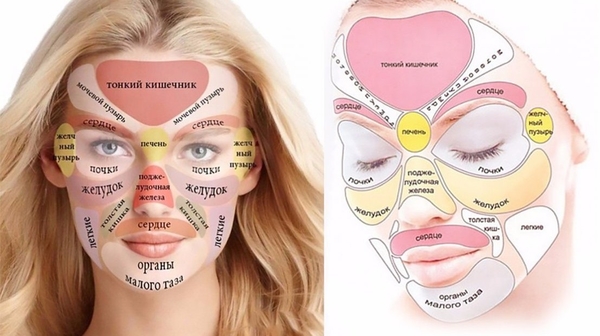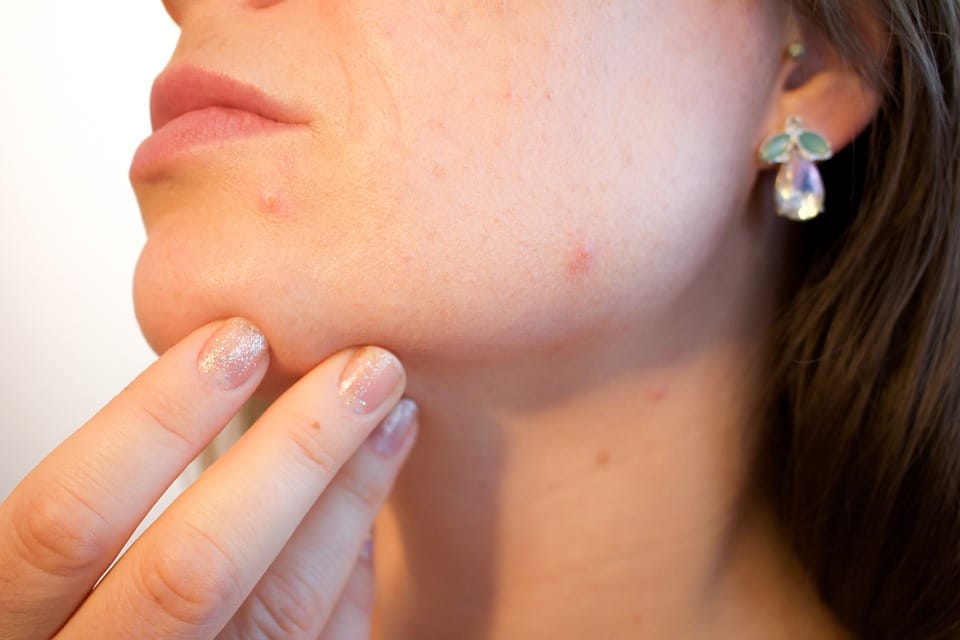It is a common belief that each area on the face is responsible for a specific organ, and, accordingly, the appearance of acne and other rashes in this area indicates a disease of this organ. We decided to check whether there is scientific evidence for this point of view.
IN Internet diverge acne cards — infographics, where each area of the face "assigned" your organ. These images post Media, shops cosmetics, women's portals And beauty blogs. This dependence is usually explain meridian theory: “In each organ, a metabolism occurs, during which chemical reactions occur and energy is released, part of it is directed to a specific area of the skin. A person’s face is very indicative for diagnosing the dysfunction of any organ. Pimples, rashes, moles on the face indicate that the energy in the meridian (channel) is not circulating correctly.” Also this dependence tie up with toxins: if they have accumulated in some organ, the body removes them in this way through the skin of the face.
Interestingly, there is no uniformity among such acne maps: alone place the pelvic organs on the chin, other - on the sides of the upper lip (and for some people in this place in general located large intestine); the tip of the nose in alone sources indicates problems with the bronchi, in others - with the pancreas; the kidneys are “located” then around the eyes, That under the eyes, or even on the ears.

Skin is the most big organ of our body. Her surface - about 2 m2, and weight is about 15% of the total body weight, that is, average of a person (weighing 62 kg), the skin will weigh almost 10 kg. In addition to the most obvious function - protective - the skin performs many other tasks: participates in thermoregulation, respiration, water-salt metabolism, synthesizes and stores useful substances (for example, vitamin D), plays a role in immunity and, with the help of receptors, transmits numerous signals to the brain from the outside world. Leather consists of of three layers: epidermis, dermis and subcutaneous tissue. The layers of the skin contain melanocytes (cells that form the pigment melanin), Langerhans cells (help to detect foreign substances and protect the body as a whole from infections), nerve endings, sweat glands, hair follicles, and fat cells. However, scientists have not yet discovered any meridians there.
Various skin problems: pimples, blackheads, acne - arise for several reasons. All of them are associated with disruption of the sebaceous glands. In addition, acne is responsible for the occurrence of acne in 80% of cases. responsible also genetics, but smoking, masturbation, nutrition, cleansing the skin or exposure to sunlight, contrary to popular belief, play almost don't play. In the development of the disease important also contribution hormones: androgens, estrogens, progesterone, insulin and some others. Besides this, exists an anaerobic bacterium that is part of the normal microflora of the body, the reproduction of which in hair follicles worsens the course of skin diseases, but it has not yet been determined whether it affects their occurrence. Some may also cause inflammation on the skin. medicines, abuse vitamin B-12, stress and regular mechanical damage epidermis.
And although the skin does remove some substances from the body (sweat, sebum), it does not allow any toxins to pass through itself simply because toxins are a well-promoted medical myth, not confirmed evidence-based methods medicine. Toxins in our body really can form under certain diseases or conditions (for example, when alcohol abuse occurs, alcohol intoxication occurs), but neither skin cleansing products nor diets, nor detox smoothies will remove them. To remove toxins exist special medical procedures that are performed as prescribed by a doctor and strictly in medical institutions.
The theory of meridians, which is used to explain the relationship between certain areas on the face and internal organs, is also unscientific. None points clusters or exit energy doesn't exist not on the ears, not on the palms, not on the skin of the face. This confirm numerous placebo-controlled research. Question existence points And therapeutic impact on them was considered also within Cochrane reviews. Participants in such studies were unable to distinguish between effects on supposedly correct points and effects on random areas of the body (which is why acne maps in different sources place different organs in different zones). Consequently, the diagnosis of diseases of internal organs based on areas of rash on the face has no scientific basis. In general, skin rashes may indicate that there are problems with some organs or organ systems. For example, skin inflammations can appear when there is a malfunction thyroid gland or when failures in the functioning of the gastrointestinal tract.
Thus, there is no point in trying to determine problems with any particular organ or organ system based on the areas of rashes on the face, since this theory has no scientific evidence. At the same time, when treating skin rashes, it would be useful to consult not only a dermatologist, but also other specialized specialists, because the very fact of the same skin inflammations may indicate different problems in the body.

Misconception
Read on the topic:
- Is it true that earlobe piercing can affect your vision?
- Is it true that the body needs to detox to remove toxins?
If you find a spelling or grammatical error, please let us know by highlighting the error text and clicking Ctrl+Enter.






